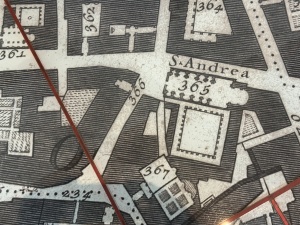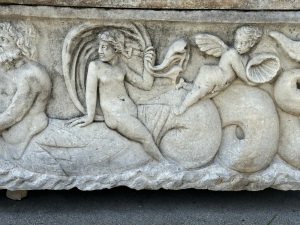I love old maps of Rome. Indeed, I have several in the apartment. It’s amazing to see what changes over time — or more accurately, being the Eternal City — what does not change over time.
Two specific maps of Rome are particularly renowned. The first is the Forma Urbis, an enormous marble map of ancient Rome created during the reign of the Emperor Septimius Severus around 21o C.E. It includes detailed carvings of the notable buildings of ancient Rome. It was once mounted on a wall in a building of the Roman Forum. But during medieval times the map was broken up, much of it used as building material or tragically burned to make lime. Some surviving parts of the Forma Urbis were preserved in the Capitoline Museums, though not exhibited cohesively, for almost a century. Until now.
The other famous map is Giovanni Battista Nolli’s 1748 Pianta Grande of Rome. This fabulous map (which you can see online) is so detailed — and accurate — that it was used for centuries. Apparently, it was used by Rome’s city planners until quite recently. I particularly love this map because it shows the block where our palazzo is located, including the little alley on the side.

Where can you see these amazing maps together today? They are both showcased in Rome’s newest museum, the Museum of the Forma Urbis. It’s literally down the street from the Colosseum, so we walked there.


The museum exhibits original fragments of the Forma Urbis, which lie under a glass floor, placed on top of the Nolli map. It’s absolutely fascinating! You can get so lost in its detail and mastery that you can spend hours with it.







While I enjoyed the museum, for some reason there was a man was sitting outside it, visible through the windows, playing a tuba. These random things seem to happen often in Rome. The music was pleasant.
After enjoying the museum, I exited to explore the new Archaeological Park of the Celio, which surrounds the museum. While there is a €9 charge for the museum, the park is free.







At the very back of the park, I found a tombstone that was incredibly touching.

It’s an ancient Roman tombstone dedicated to a beloved little dog. It even tells us his name — Heursis, which translates as “the finder.” Someone loved their dog enough to have spent an awful lot of money to memorialize him this way. While his head is missing, you can see from the animated way his body is depicted that he was an energetic pooch. While we are separated from Heursis’ owner by thousands of years, he (or she) was no different from us. That dog was a beloved part of the family, just like how pet lovers today feel about their furry companions. The thought brought a smile to my face. Some things change over time, but some are eternal.
I walked back to the museum for a brief rest before walking back to the metro. To my surprise, music was emanating from a door at the end of the museum building. I peeked inside and saw that a band was practicing. So we sat on the steps leading to the door for a few minutes and enjoyed the music. Just another wonderful day in the Eternal City.
